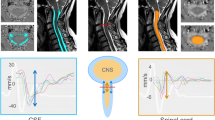Abstract
While ectopic gas can be a sign of dangerous disease requiring immediate medical or surgical intervention, it can also be an incidental and benign finding. Intravenous gas and spinal vacuum gas are common and almost always benign. Intravascular gas is most often related to instrumentation and, if intraarticular, can cause end-organ ischemia; however, treatment is usually supportive. Pneumocephalus arises from a communication with paranasal sinuses or mastoids more often than from meningeal infection and can usually be managed nonoperatively. In part 3 of this series, the different causes of ectopic gas in the vessels, skull, and spine are reviewed, as are the imaging features that can help to narrow the differential diagnosis.









Similar content being viewed by others
References
Freund MC, Petersen J, Goder KC, Bunse T, Wiedermann F, Glodny B (2012) Systemic air embolism during percutaneous core needle biopsy of the lung: frequency and risk factors. BMC Pulm Med 12:2. doi:10.1186/1471-2466-12-2
Hare SS, Gupta A, Goncalves AT, Souza CA, Matzinger F, Seely JM (2011) Systemic arterial air embolism after percutaneous lung biopsy. Clin Radiol 66(7):589–596. doi:10.1016/j.crad.2011.03.005
DeGorordo A, Vallejo-Manzur F, Chanin K, Varon J (2003) Diving emergencies. Resuscitation 59(2):171–180. doi:10.1016/s0300-9572(03)00236-3
Groell R, Schaffler GJ, Rienmueller R, Kern R (1997) Vascular air embolism: location, frequency, and cause on eletron-beam CT studies of the chest. Radiology 202(2):459–462
Tran P, Reed EJM, Hahn F, Lambrecht JE, McClay JC, Omojola MF (2010) Incidence, radiographical features, and proposed mechanism for pneumocephalus from intravenous injection of air. West J Emerg Med 11(2):180–185
Park EY, Kwon JY, Kim KJ (2012) Carbon dioxide embolism during laparoscopic surgery. Yonsei Med J 53(3):459–466. doi:10.3349/ymj.2012.53.3.459
Kizer KW, Goodman PC (1982) Radiographic manifestations of venous air embolism. Radiology 144:35–39
Michel SJ (2004) The Mount Fuji sign. Radiology 232:449–450
Pantangi P, Cherian SV (2011) Pneumocephalus; a rare presentation of streptococcal meningitis. Intern Med 50(19):2249–2250. doi:10.2169/internalmedicine.50.5969
Goyal M, Sharma R, Berry M (1996) Diffuse pneumocephalus due to meningitis: CT findings. Pediatr Radiol 26:278–279
Coulier B (2004) The spectrum of vacuum phenomenon and gas in the spine. JBR-BTR 87:9–16
Kummel H (1895) Uber die traumatischen Erkrankungen der Wirbelsaule. Dtsch Med Wochenschr 21:180–181
Maldague BE, Noel HM, Malghem JJ (1978) The intravertebral vacuum cleft: a sign of ishcemic verteral collapse. Radiology 129:23–29
Belotti EA, Rizzi M, Rodoni-Cassis P, Ragazzi M, Zanolari-Caledrerari M, Bianchetti MG (2010) Air within the spinal canal in spontaneous pneumomediastinum. Chest 137(5):1197–1200. doi:10.1378/chest.09-0514
Acknowledgements
No grant funding or other financial support was received for this work.
Author information
Authors and Affiliations
Corresponding author
Ethics declarations
Conflict of interest
The authors declare that they have no conflict of interest.
Rights and permissions
About this article
Cite this article
Sandstrom, C.K., Osman, S.F. & Linnau, K.F. Scary gas: intravascular, intracranial, and intraspinal ectopic gas (part III). Emerg Radiol 24, 411–416 (2017). https://doi.org/10.1007/s10140-017-1492-8
Received:
Accepted:
Published:
Issue Date:
DOI: https://doi.org/10.1007/s10140-017-1492-8




